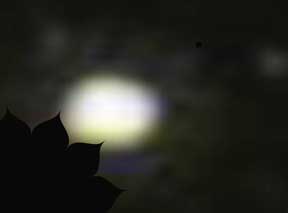|
News Notes
Planetary astronomy
Floral shade aids search for Earths
 The search continues for the Earth-like planets that scientists think are most likely to harbor life, and a newly refined sunflower-shaped device could one day reveal scores of candidates currently obscured by their neighboring star’s light.
The search continues for the Earth-like planets that scientists think are most likely to harbor life, and a newly refined sunflower-shaped device could one day reveal scores of candidates currently obscured by their neighboring star’s light.
In this schematic, a newly refined flower-shaped shield passes in front of a star, which could effectively shield a space-based telescope from the star’s bright light. The design could help astronomers to locate dim Earth-like planets orbiting close to overwhelmingly bright stars. Image is courtesy of Northrop Grumman Corporation.
To aid in the search, NASA previously called for the development of advanced
optics inside a space-based telescope to dim oppressively bright starlight.
But that project, called Terrestrial Planet Finder, was “deferred
indefinitely,” according to NASA’s Fiscal Year 2007 budget
request.
Webster Cash, an astrophysicist at the University of Colorado in Boulder,
however, says that she is hopeful that NASA’s interest will be piqued
by a cheaper and less risky alternative: deploying a shield beyond a space-based
telescope to block out light from the star. The concept was studied in
1961, but light still managed to bend around the edges of the circular
shield that was used, Cash says.
Changing the shield shape from a circle to a flower, however, cancels out the extra light. Cash described the “perfected” mathematical equations that exactly define the flower shape in the July 6 Nature.
The new design, he says, increases the darkness 100,000 times over previous models. And compared to looking for planets with no shield at all, the increase in darkness equates to the difference between looking straight into the sun and looking at Mars at midnight, Cash says. That makes “all the difference in the world,” he says, for astronomers trying to spot planets outshined by a nearby star. Earth, for example, is 10 billion times fainter than the sun.
The shield currently remains in the concept phase of what Cash and colleagues call the New Worlds Observer mission. If built, the device would measure 30 to 50 meters across and be made from three layers of material similar to plastic trash bags.
Cash says that a shield could be built to work in concert with NASA’s currently planned space-based James Webb Telescope. If NASA agrees to fund that plan, the shield alone could be built by 2013 and would cost about $400 million, he says.
The preferred option, however, he says, is to launch the shield along with a new, specially designed telescope that can use photometry (to detect possible land and oceans) and spectroscopy (to detect atmospheric oxygen and methane). A new shield and telescope together would cost about $2 billion, and could launch within a decade, Cash says: “I’m very excited about the potential to search for oceans, beaches and slime planets.”
Kathryn Hansen
Links:
"Planet-Finder's Guide to the Universe," Geotimes, July 2005

 Subscribe
Subscribe

